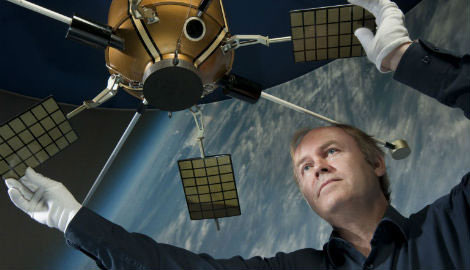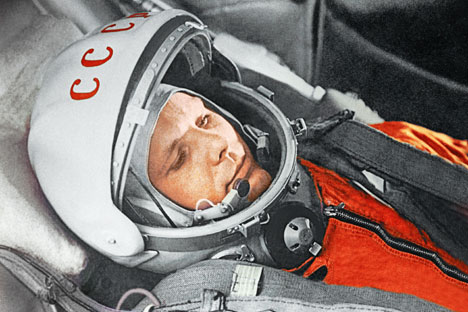
Curator of 'Cosmonauts: Birth of the Space Age' exhibition, Doug Millard. Source: personal archive
Entitled "Cosmonauts: Birth of the Space Age," the new exhibition in London's Science Museum will take visitors through more than 100 years' history – from fascination with space exploration to actual space missions.
Intended to be the Year of Russian Culture in the UK's closing event, the exhibition was postponed several times, raising doubts about whether it would go ahead.
Now the opening day has finally been announced, RBTH spoke with curator Doug Millard about the exhibition's concept, highlights and challenges in putting it together.
RBTH: The exhibition was conceived four years ago, on the 50th anniversary of the Yuri Gagarin mission. What do you expect to achieve with the exhibition and why was the Science Museum chosen as the venue?
Doug Millard: This exhibition is doing two things. It is telling the story of the first space nation, but also looks at that nation through the lens of space. It is unique because this collection of space items and spacecraft has never been brought together before anywhere in the world. The Science Museum has long displayed the story of space exploration but for many years we underplayed the Soviet and Russian contributions. We are now hoping to redress the balance by telling the story of how Russia went into space.
RBTH: The opening date was originally scheduled for last autumn but then it was repeatedly pushed back. Why was that?
D.M.: We've been very demanding with our requests, borrowing some very important spacecraft that have never been outside Russia before. So there was a lot of negotiating to do. Until we had absolutely every agreement sorted out, we weren't able to move ahead.

Space suits could become one of the most popular part of the exhibition. Source: TASS / Igor Kubedinov
RBTH: What was the most difficult part of putting the exhibition on?
D.M.: The biggest challenge was borrowing spacecraft from some of the space enterprises. They are not in the business of lending items to other parties, particularly, to other countries. They are in the business of building spacecraft and rockets and launching them. So, there was a lot of paperwork that needed to be actually invented to make this work. In many ways, both ourselves here in London and our friends in Moscow were learning how to do this for the first time.
RBTH: What exhibits are going to be most interesting for vistiors, specifically the younger generation?
Display items have been sourced from various places, including Enegria and Lavochkin enterprises, the Cosmonautical Museum of Moscow, the Tsiolkovsky State Museum of Cosmonautics in Kaluga and even the Tretyakov Gallery.
D.M.: I think youngsters will have several favorites. They will like some of the space suits - they are always very popular. They'll also be very taken with some of the equipment you need to stay alive in space. So, for example, a space toilet will get lots of attention. But perhaps the object that will be most dramatic, which may linger longest in their memory, is the lunar lander, the LK-3, which was designed to take a single cosmonaut down to the lunar surface. Unfortunately, the program was cancelled, but we've managed to bring it over from the Moscow Aviation Institute.
RBTH: You've just spoken about major spacecraft and equipment, but to people involved in space exploration, it was also a personal thing. Are the exhibition's viewers going to see something related to that aspect?
Some people might be surprised to learn that the opening sections of the exhibition, which follows a chronological narrative, deal with an era that preceded the first space missions by more than 50 years.
D.M.: We've talked about some of the larger [exhibits], spacecraft and modules, but there is a very small item, which was presented to Yuri Gagarin when he was visiting Japan around 1962 or 1963. That's a delightful little Japanese doll. And this was actually taken up into space by the first Japanese cosmonaut – partly as a memento, a talisman, with Gagarin's blessing, but also a simple scientific instrument. This little doll was suspended in front of a camera in the spacecraft cabin and when it achieved orbit, it became weightless and started floating around the cabin, showing that orbital velocity had been achieved.

Yuri Gagarin. Source: RIA Novosti
RBTH: Why does the exhibition start at the turn of the 20th century?
D.M.: That is because we are looking at the cultural roots of Russia's interest in space. And that's one of the reasons we have works of art from the Tretyakov Gallery, displaying constructivist and supremacist ways of thinking. Although there are lots of amazing, out of this world technology, which I think will interest many people who perhaps wouldn't normally come to the Science Museum.
RBTH: People in the UK know Gagarin. Are there other Soviet/Russian cosmonauts featured in the exhibition?
D.M.: We mention a lot of cosmonauts – Valentina Tereshkova obviously, as the first woman to travel into space. We have her spacecraft on display. We also have the Voskhod-1 descent module, which carried a crew of three into space, including [Vladimir] Komarov. Komarov was tragically killed on the first Soyuz mission [in 1967]. So, that little section deals with both triumph and tragedy. We talk also about Vladimir Dzhanibekov, who with his colleague carried out the resuscitation of a dead space station, Salyut-7, which was drifting cold and lifeless in space [in 1985]. They docked with it and brought it back to life, a really incredibly dangerous mission.
RBTH: Do you already have an idea of what audience the exhibition is likely to attract?
Covering more than a hundred years, from the late 19th century dreams of space exploration, through World War II and into the space age from 1957 onwards, the exhibition is not limited to history. Its final section looks into the future, speculating about the future of human space exploration.
D.M.: When we had the Gagarin celebrations back in 2011, I think you could split people in two groups. There were those who could remember Gagarin's mission and his visit to London and Manchester. Almost without exception, most people had very happy memories of a very personable, very charismatic young man who had been the first human to fly into space. Gagarin made a tremendous impression during his visit to Britain. Then there were younger people, who were not born when Gagarin's mission flew, and they were very interested in learning more about not just his space flight, but also the other ones that followed.
All rights reserved by Rossiyskaya Gazeta.
Subscribe
to our newsletter!
Get the week's best stories straight to your inbox